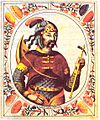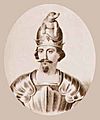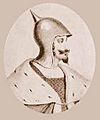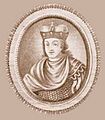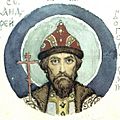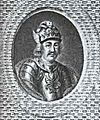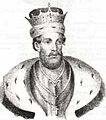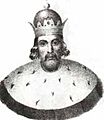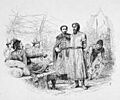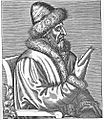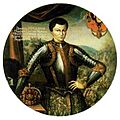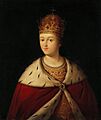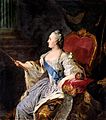List of Russian Monarchs facts for kids
This is a list of all the kings and queens, also known as monarchs, who ruled Russia throughout history. It starts with Prince Rurik in 862 and ends with Emperor Nicholas II, who stepped down from the throne in 1917 and passed away in 1918.
Contents
Early Rulers of Russia
Russia's history of rulers began with princes in different cities, before a single powerful state emerged.
Princes of Novgorod
Novgorod was one of the first important cities in early Russia. Here are some of its early rulers:
- Rurik (ruled 862–879): He is considered the founder of the first Russian ruling family, the Rurikids.
- Oleg of Novgorod (ruled 879–882): He was a regent (someone who rules for a young monarch) for Rurik's son, Igor.
Grand Princes of Kiev
Kiev became a very important city, and its rulers were called Grand Princes. They were powerful leaders who united many lands.
- Askold and Dir (ruled 842 or 862–882): These were early rulers in Kiev before the Rurikid family took over.
- Oleg of Novgorod (ruled 882–912): He moved the capital from Novgorod to Kiev, making Kiev the center of power.
- Igor I (ruled 913–945): Rurik's son, he continued to expand the lands.
- Saint Olga of Kiev (ruled 945–962): Igor's wife, she ruled as a regent for her young son, Sviatoslav. She was known for her wisdom.
- Sviatoslav I the Great (ruled 945–972): A brave warrior who expanded the territory of Kievan Rus'.
- Vladimir I the Great (ruled 980–1015): He is famous for making Christianity the official religion of Kievan Rus'.
- Yaroslav I the Wise (ruled 1016–1018, then 1019–1054): He was known for creating laws and building churches.
- Vladimir II Monomakh (ruled 1113–1125): A strong ruler who brought peace and order.
- Mstislav the Great (ruled 1125–1132): He continued his father's work in strengthening the state.
- Yuri I the Long Arms (ruled 1149–1150, 1150, 1155–1157): He founded Moscow and fought for control of Kiev.
Grand Princes of Vladimir
Over time, the center of power shifted from Kiev to the city of Vladimir.
- Saint Andrei I Bogolyubsky (ruled 1157–1174): He moved the capital to Vladimir and made it a powerful center.
- Vsevolod III the Big Nest (ruled 1176–1212): He had many children, which is why he was called "the Big Nest." His reign was a time of great power for Vladimir.
- Yuri II (ruled 1212–1216, then 1218–1238): He faced invasions and died in battle.
- Saint Alexander I Nevsky (ruled 1252–1263): A famous military leader who defended Russia from invaders.
- Saint Michael of Tver (ruled 1304–1318): He was a strong ruler who tried to unite Russian lands.
- Ivan I of Moscow Kalita (ruled 1332–1340): He was called "Kalita" (moneybag) because he was very wealthy and used his money to strengthen Moscow.
Since 1331, the title of Grand Prince of Vladimir was often held by the Princes of Moscow, showing Moscow's growing importance.
Grand Princes of Moscow
Moscow became the new center of power, and its princes laid the foundation for the future Russian state.
- Daniel (ruled 1283–1303): The first Prince of Moscow, he was the son of Alexander Nevsky.
- Yury (ruled 1303–1325): Daniel's son, he continued to expand Moscow's influence.
- Ivan I Kalita (ruled 1325–1340): He made Moscow very strong and rich.
- Simeon the Proud (ruled 1340–1353): Ivan I's son, he continued to build Moscow's power.
- Ivan II the Handsome (ruled 1353–1359): Simeon's brother, he ruled during a difficult time.
- Saint Dmitry I Donskoy (ruled 1359–1389): A hero who led Russian forces to a major victory against invaders.
- Vasily I (ruled 1389–1425): Dmitry's son, he further expanded Moscow's territory.
- Vasily II the Blind (ruled 1425–1434, 1435–1446, 1447–1462): He faced many challenges and conflicts during his long reign.
- Ivan III the Great (ruled 1462–1505): He greatly expanded Russia's territory and is often called the "gatherer of Russian lands."
- Vasily III (ruled 1505–1533): Ivan III's son, he continued his father's work of uniting Russia.
- Ivan IV the Terrible (ruled 1533–1547 as Grand Prince): He was the last Grand Prince of Moscow before becoming the first Tsar.
Tsars of Russia
Dates are listed in the Old Style, which was used in Russia at the time.
House of Rurikovich
The Rurikid family continued to rule, but now with the grander title of Tsar.
- Ivan IV the Terrible (ruled 1547–1584): He was the first ruler to be crowned Tsar of All Russia. He made Russia much larger and more powerful.
- Feodor I (ruled 1584–1598): Ivan IV's son, he was a religious and peaceful ruler.
Time of Troubles
After Feodor I, Russia went through a difficult period called the "Time of Troubles," with many different rulers and much instability.
House of Godunov
- Boris I (ruled 1598–1605): He was a powerful noble who became Tsar after Feodor I.
- Feodor II (ruled 1605): Boris Godunov's son, he ruled for a very short time.
Pseudo-Rurikovich Usurpers
During the Time of Troubles, several people claimed to be the rightful heir, but they were not.
- False Dmitry I (ruled 1605–1606): He claimed to be Ivan IV's son, Dmitry, who was thought to be dead.
- False Dmitry II (ruled 1607–1610): Another person who claimed to be Dmitry.
- False Dmitry III (ruled 1611–1612): Yet another person claiming to be Dmitry.
House of Shuysky
- Vasiliy IV (ruled 1606–1610): A noble from the Rurikid family, he became Tsar during the Time of Troubles but was later removed from power.
House of Vasa
- Vladislav I (ruled 1610–1612): A Polish prince who was elected Tsar but never actually ruled Russia.
House of Romanov
The Romanov family came to power after the Time of Troubles, bringing stability and ruling Russia for over 300 years.
- Michael I (ruled 1613–1645): The first Romanov Tsar, he was chosen to bring peace after the Time of Troubles.
- Alexis I the Quietest (ruled 1645–1676): Michael's son, he oversaw many changes in Russian law and society.
- Feodor III (ruled 1676–1682): Alexis's son, he had a short reign due to poor health.
- Sophia (regent 1682–1689): Alexis's daughter, she was a powerful regent for her young brothers, Ivan V and Peter I.
- Ivan V (ruled 1682–1696): He ruled jointly with his younger half-brother, Peter I.
- Peter I the Great (ruled 1682–1721 as Tsar): He was one of Russia's most famous rulers, known for modernizing the country and making it a major European power. He changed his title from Tsar to Emperor in 1721.
Emperors of Russia
Peter the Great changed Russia's title from a Tsardom to an Empire, and its rulers became Emperors and Empresses.
- Peter I the Great (ruled 1721–1725 as Emperor): He continued his reforms, building the new capital city of St. Petersburg.
- Catherine I (ruled 1725–1727): Peter the Great's wife, she became Empress after his death.
- Peter II (ruled 1727–1730): Peter the Great's grandson, he was a young emperor who died without children.
- Anna (ruled 1730–1740): Peter the Great's niece, she ruled after Peter II.
- Ivan VI (ruled 1740–1741): A baby emperor, he was overthrown shortly after taking the throne.
- Elizabeth (ruled 1741–1762): Peter the Great's daughter, her reign was known for its elegance and cultural growth.
- Peter III (ruled 1762): Elizabeth's nephew, he ruled for a very short time before being removed from power.
- Catherine II the Great (ruled 1762–1796): Peter III's wife, she was a very powerful and influential ruler who expanded Russia's borders and supported arts and sciences.
- Paul I (ruled 1796–1801): Catherine the Great's son, his reign was marked by military reforms.
- Alexander I the Blessed (ruled 1801–1825): Paul I's son, he led Russia during the Napoleonic Wars.
- Nicholas I (ruled 1825–1855): Alexander I's brother, he was a strong and strict ruler.
- Alexander II the Liberator (ruled 1855–1881): Nicholas I's son, he is famous for freeing the serfs (peasants tied to the land).
- Alexander III the Peace-Maker (ruled 1881–1894): Alexander II's son, his reign was a time of peace for Russia.
- Saint Nicholas II (ruled 1894–1917): Alexander III's son, he was the last Emperor of Russia. He stepped down from the throne in 1917.
- Michael II (ruled 1917): Nicholas II's brother, he was briefly offered the throne but declined it, marking the end of the monarchy in Russia.
Images for kids


